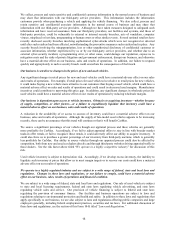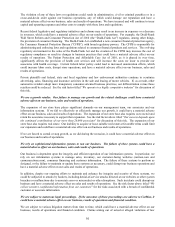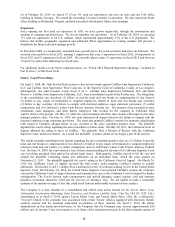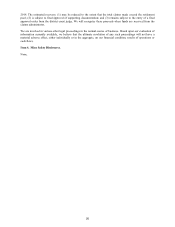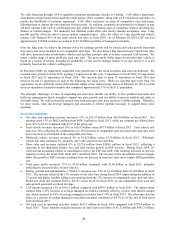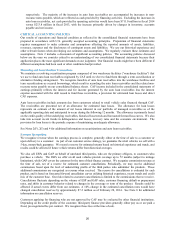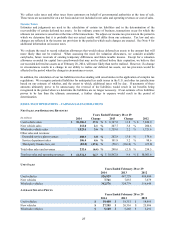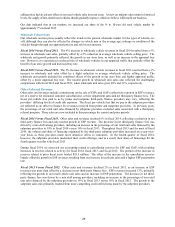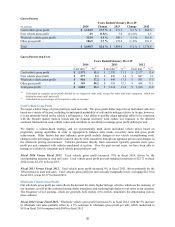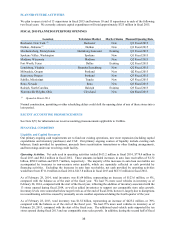CarMax 2014 Annual Report Download - page 29
Download and view the complete annual report
Please find page 29 of the 2014 CarMax annual report below. You can navigate through the pages in the report by either clicking on the pages listed below, or by using the keyword search tool below to find specific information within the annual report. 25
We offer financing through CAF to qualified customers purchasing vehicles at CarMax. CAF utilizes proprietary
customized scoring models based upon the credit history of the customer, along with CAF’s historical experience, to
predict the likelihood of customer repayment. CAF offers customers an array of competitive rates and terms,
allowing them to choose the ones that best fit their needs. In addition, customers are permitted to refinance or pay
off their contract with CAF or a third-party provider within three business days of a purchase without incurring any
finance or related charges. We randomly test different credit offers and closely monitor acceptance rates, 3-day
payoffs and the effect on sales to assess market competitiveness. After the effect of 3-day payoffs and vehicle
returns, CAF financed 41% of our retail vehicle unit sales in fiscal 2014. As of February 28, 2014, CAF serviced
approximately 532,000 customer accounts in its $7.18 billion portfolio of managed receivables.
Over the long term, we believe the primary driver for earnings growth will be vehicle unit sales growth from both
new stores and stores included in our comparable store base. We also believe that increased used vehicle unit sales
will drive increased sales of wholesale vehicles and ancillary products and, over time, increased CAF income. We
target a dollar range of gross profit per used unit sold. The gross profit dollar target for an individual vehicle is
based on a variety of factors, including its probability of sale and its mileage relative to its age; however, it is not
primarily based on the vehicle’s selling price.
In December 2008, we temporarily suspended store growth due to the weak economic and sales environment. We
resumed store growth in fiscal 2011, opening 3 superstores in that year, 5 superstores in fiscal 2012, 10 superstores
in fiscal 2013 and 13 superstores in fiscal 2014. We currently plan to open 13 superstores in fiscal 2015 and
between 10 and 15 superstores in each of the following two fiscal years. While we currently have more than 130
superstores, we are still in the midst of the national rollout of our retail concept, and as of February 28, 2014, we had
used car superstores located in markets that comprised approximately 57% of the U.S. population.
The principal challenges we face in expanding our store base include our ability to hire qualified associates and
build our management bench strength to support our store growth, and our ability to procure suitable real estate at
favorable terms. We staff each newly opened store with associates who have extensive CarMax training. Therefore,
we must recruit, train and develop managers and associates to fill the pipeline necessary to support future store
openings.
Fiscal 2014 Highlights
Net sales and operating revenues increased 15% to $12.57 billion from $10.96 billion in fiscal 2013. Net
earnings grew 13% to $492.6 million from $434.3 million in fiscal 2013, while net earnings per diluted share
grew 16% to $2.16, compared with $1.87 in the prior year.
Used vehicle revenues increased 18% to $10.31 billion versus $8.75 billion in fiscal 2013. Used vehicle unit
sales rose 18%, reflecting the combination of a 12% increase in comparable store used unit sales and sales from
newer stores not yet included in the comparable store base.
Wholesale vehicle revenues increased 4% to $1.82 billion versus $1.76 billion in fiscal 2013. Wholesale
vehicle unit sales increased 5%, primarily due to the growth in our store base.
Other sales and revenues declined 6% to $232.6 million from $248.6 million in fiscal 2013, reflecting a
reduction in net third-party finance fees and only modest growth in ESP revenue. During fiscal 2014, we
corrected our accounting related to cancellation reserves for ESP and GAP, with resulting increases in reserves
related to activity for fiscal 2014, fiscal 2013, and fiscal 2012. The increase in the cancellation reserves largely
offset the growth in ESP revenues resulting from our increase in used unit sales and a higher ESP penetration
rate.
Total gross profit increased 13% to $1.65 billion compared with $1.46 billion in fiscal 2013, primarily
reflecting the increased sales of used vehicles.
Selling, general and administrative (“SG&A”) expenses rose 12% to $1.16 billion from $1.03 billion in fiscal
2013. The increase reflected the 11% increase in our store base during fiscal 2014 (representing the addition of
13 stores) and higher variable selling costs resulting from the 12% increase in comparable store used unit sales.
SG&A per retail unit declined $102 to $2,161 versus $2,263 in fiscal 2013, as our comparable store used unit
sales growth generated overhead leverage.
CAF income increased 12% to $336.2 million compared with $299.3 million in fiscal 2013. The improvement
resulted from a 23% increase in average managed receivables, partially offset by a lower total interest margin
rate, which declined to 6.9% of average managed receivables from 7.4% in fiscal 2013. The allowance for loan
losses as a percent of ending managed receivables remained consistent at 0.97% as of the end of both fiscal
2014 and fiscal 2013.
Net cash used in operating activities totaled $613.2 million in fiscal 2014 compared with $778.4 million in
fiscal 2013. These amounts included increases in auto loan receivables of $1.32 billion and $992.2 million,


